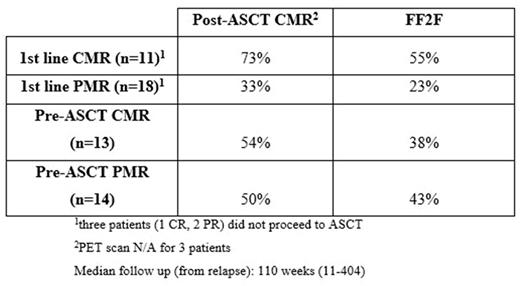Abstract
Background:
Approximately 25% of patients with cHL have relapsed or refractory (r/r) disease. Although salvage chemo-radiotherapy followed by autologous stem cell transplant (ASCT) offers the best chance of freedom from treatment failure (FFTF) (~50%), a portion patients have a poor prognosis despite this approach. Traditional prognostic scores are less well validated than in de novo disease, and hence 18F-FDG PET-CT, the gold-standard imaging modality in cHL, has an increasing role as a powerful prognostic indicator in this context.
Our aims were a) to compare response rates to salvage therapy using 18F-FDG PET-CT (reported according to Lugano 2014 criteria) with trial-reported outcomes; and b) to assess the prognostic value of 18F-FDG PET-CT in this context.
Method:
Retrospective data were collected on r/r cHL patients treated across 3 UK hospital sites (2011-2017). PET-CT scans were retrospectively reviewed according to Lugano 2014 response criteria i.e. complete metabolic response (CMR), partial metabolic response (PMR), no metabolic response (NMR) and progressive metabolic disease (PMD). Prognostic scores were calculated as described by Jostings et al. 2000.
Results:
34 patients were identified: 21 with refractory cHL (<90 days) and 13 with relapsed disease. Median age was 43 years (range 14-77). Median time to relapse was 94 weeks (193-687). 100% patients had a prognostic score of <2, with 90% <1 (score unable to be calculated: n=2). 88% patients achieved an overall response (ORR) after 1st line salvage therapy, with 33% achieving CMR and 55% PMR (18F-FDG PET not performed: n=1). Patients were treated with 1-4 lines of salvage therapy (median= 1), with 33% receiving brentuximab vedotin. Of the 82% patients that proceeded to ASCT, 46% were in CMR, 50% were in PMR and 4% had mixed disease response. 47% of patients achieved CMR post-ASCT, with FFTF in 37% (Post-ASCT 18F-FDG PET unavailable: n=3). As shown in the table below, there was a 55% rate of FFTF in patients with CMR post 1st line salvage therapy, compared with a 23% rate of FFTF in patients with PMR post 1st line salvage. 38% of patients with an overall CMR pre-ASCT had FFTF, compared with 43% with overall PMR.
Conclusion:
There is a wide discrepancy in FFTF, comparable with previous trial data, between patients achieving CMR and those achieving a PMR on 18F-FDG PET-CT post 1st line salvage chemotherapy. However, patients who received multiple lines of salvage therapy achieved similar rates of FF2F, irrespective of their metabolic response on their pre-ASCT 18F-FDG PET-CT. This suggests that 18F-FDG PET-CT may have limited prognostic value in this setting.
Hildyard: ADC Therapeutics: Research Funding. Collins: Pfizer: Consultancy, Honoraria; ADC Therapeutics: Research Funding; MSD: Consultancy, Honoraria; Celleron: Consultancy; Takeda: Consultancy, Honoraria, Speakers Bureau; Roche: Consultancy, Honoraria, Speakers Bureau; Bristol-Myers Squibb: Research Funding; Celgene: Research Funding; Amgen: Research Funding.
Author notes
Asterisk with author names denotes non-ASH members.


This feature is available to Subscribers Only
Sign In or Create an Account Close Modal